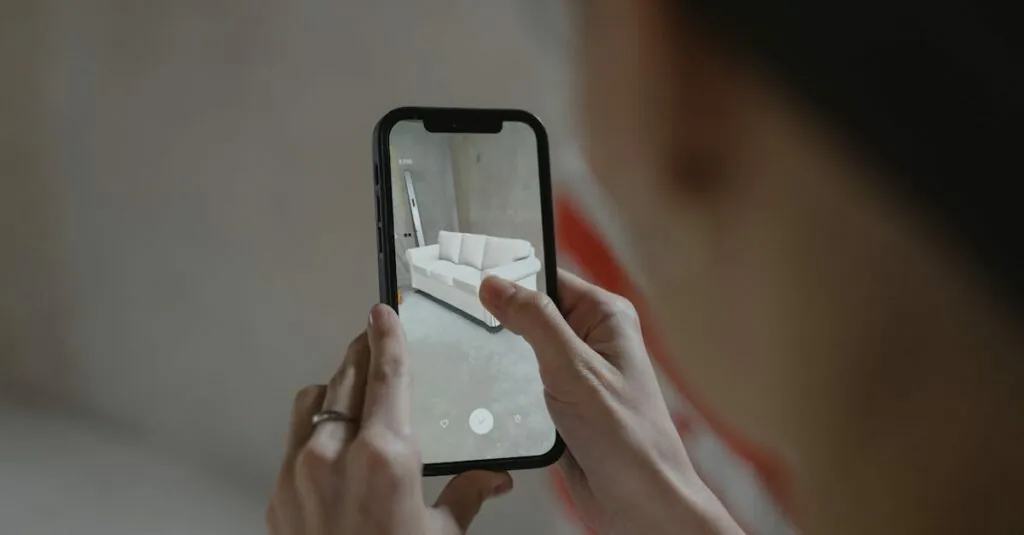Table of Contents
ToggleIn a world where speed is king, finding out if your iPhone is 5G can feel like a high-stakes treasure hunt. After all, who wouldn’t want to surf the web faster than a caffeinated squirrel? With 5G networks popping up like mushrooms after a rainstorm, it’s crucial to know if your trusty device can handle the lightning-fast speeds that come with it.
Understanding 5G Technology
5G technology represents the fifth generation of mobile network technology, offering significant improvements over previous generations. This technology delivers higher data speeds, reduced latency, and increased connectivity for a vast number of devices. Enhanced user experiences emerge with faster download and upload speeds, which can reach up to 10 Gbps in ideal conditions.
Mobile users benefit from 5G’s capacity to support more connected devices. In densely populated areas, many devices maintain connectivity without experiencing slowdowns. This capability caters to demanding applications like virtual reality, augmented reality, and IoT.
Infrastructure serves as a critical component of 5G deployment. Network operators invest in dense cell tower installations to improve coverage and reliability. Different spectrum bands operate within 5G technology: low-band offers broad coverage, mid-band provides a balance between speed and coverage, and high-band (mmWave) delivers ultra-fast speeds but shorter range.
Compatibility plays a key role in accessing 5G networks. An iPhone model needs to support 5G technology to utilize these capabilities. Some regions might not yet have 5G coverage, making it essential to check local availability.
For individuals looking to explore 5G features, Apple has integrated indicators on its devices. An icon appears in the status bar when connected to a 5G network. Checking carrier settings also provides insight into having the latest updates for optimal performance.
Overall, understanding the fundamentals of 5G technology aids in determining if an iPhone can leverage its strengths. Identifying these components leads to better-informed decisions about upgrading devices or changing plans.
How to Identify Your iPhone Model
Identifying your iPhone model ensures you know if it supports 5G technology. Checking your model number or using the Settings app can simplify this process.
Checking Model Number
Locate your model number for clarity. Find it in the settings by navigating to General, then About. Numbers begin with an “A,” followed by four digits, such as A2342. Alternatively, inspect the back of your device; some models list the number there. Additionally, you can cross-reference the model number with Apple’s official website for a complete list of models. Be aware that only specific models, starting from iPhone 12, support 5G, so knowing the exact number is crucial.
Using the Settings App
Utilize the Settings app for an efficient check. Open Settings and select General, followed by About. Look for the “Model Name” section to view your device’s name. When you see options like iPhone 12, iPhone 13, or newer, your device supports 5G. Furthermore, check the “Cellular” section to ensure 5G is enabled if your model is compatible. This method offers a straightforward way to confirm 5G readiness.
Determining 5G Capability
Determining if an iPhone is 5G capable involves a few straightforward checks. Users can rely on the settings and carrier information to confirm compatibility.
Network Settings
Network settings provide essential insights into 5G capability. Navigate to Settings, then select Cellular, and check for options related to 5G. An option labeled “Voice & Data” indicates the presence of 5G options if the iPhone is compatible. Users should also see statuses showing current connectivity, like “5G On” or “5G Auto.” These indicators confirm that the device connects to 5G networks where available. If there are no 5G options listed, the iPhone might not support the technology.
Carrier Compatibility
Carrier compatibility plays a vital role in accessing 5G services. Major carriers, such as Verizon, AT&T, and T-Mobile, actively support 5G networks, but not all plans include 5G access. It’s crucial to verify the current plan and its coverage areas. . iPhones that support 5G will typically work better with carriers providing extensive 5G infrastructure. Users can check with their carrier to confirm compatibility with 5G networks. Identifying the right carrier ensures the best experience with 5G connectivity.
Verifying 5G Connectivity
Verifying if an iPhone supports 5G is essential for enjoying faster internet speeds. Users can check this through various methods, including applications and network indicators.
Speed Test Applications
Speed test applications offer a reliable way to assess network performance. Popular apps like Ookla Speedtest or Fast.com measure download and upload speeds. Downloading one of these apps provides instant feedback on your current connection. If the results indicate speeds around or above 100 Mbps, that suggests a potential 5G connection, depending on the network parameters. Checking speeds at different times and locations helps understand network consistency and reliability.
Network Indicators
Network indicators provide immediate visual cues regarding connectivity. Users can look at the status bar on their iPhones for symbols representing network types. If they see “5G,” that’s a clear sign the device is on a 5G network. Additionally, accessing settings can reveal more details about the connection type. Going to Settings, tapping Cellular, then selecting Cellular Data Options shows if 5G functionality is enabled. Keeping an eye on these indicators ensures users stay informed about their network experiences.
Determining if an iPhone is 5G capable is essential for users looking to enhance their mobile experience. By following simple steps to check the model number and settings, users can quickly confirm compatibility. Keeping an eye on network indicators and utilizing speed tests further ensures that they’re making the most of their device’s capabilities.
As 5G technology continues to evolve, staying informed about local coverage and carrier options will help users maximize their connectivity. With the right tools and knowledge, enjoying the benefits of 5G can become a seamless part of daily life.




